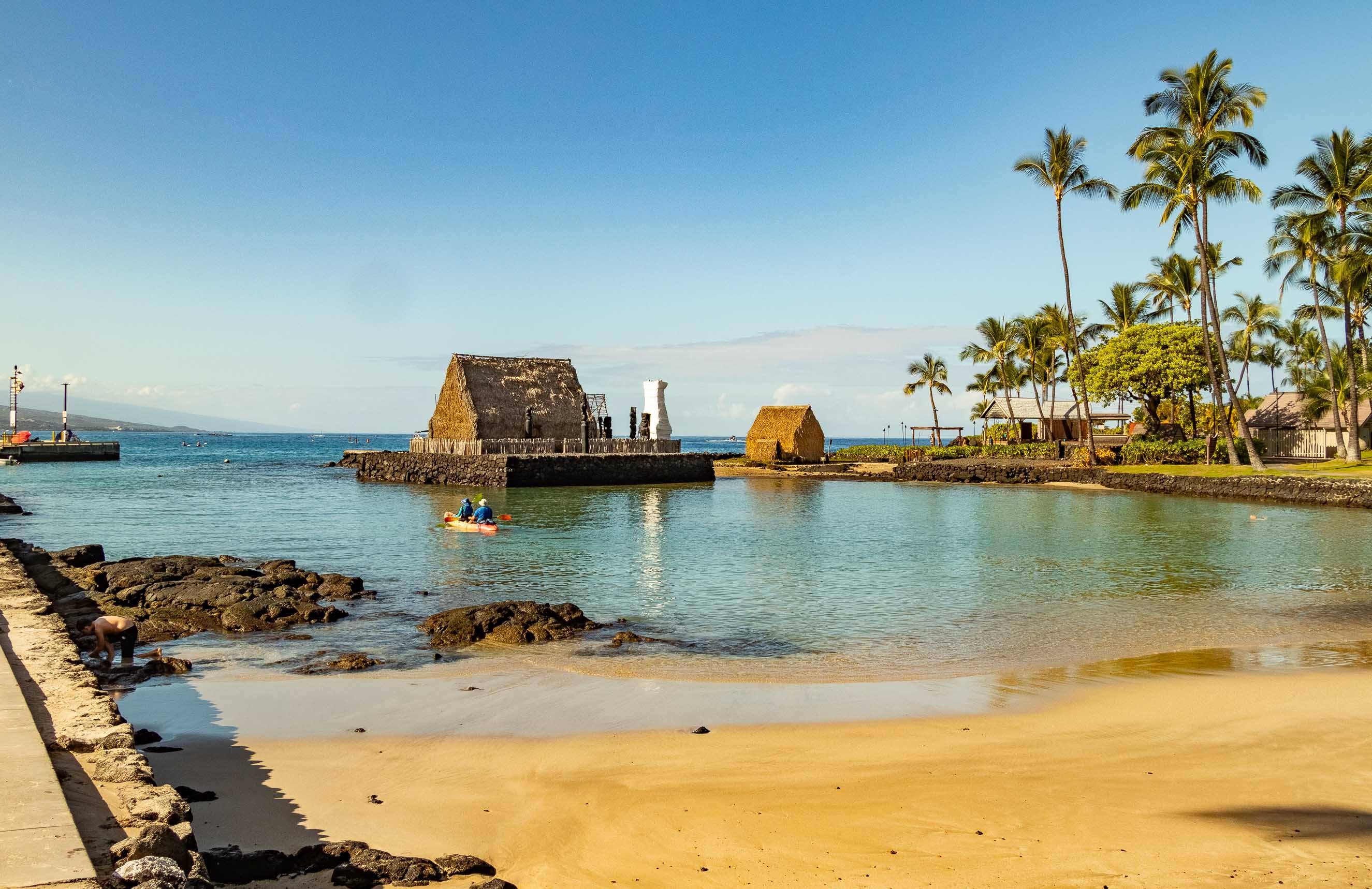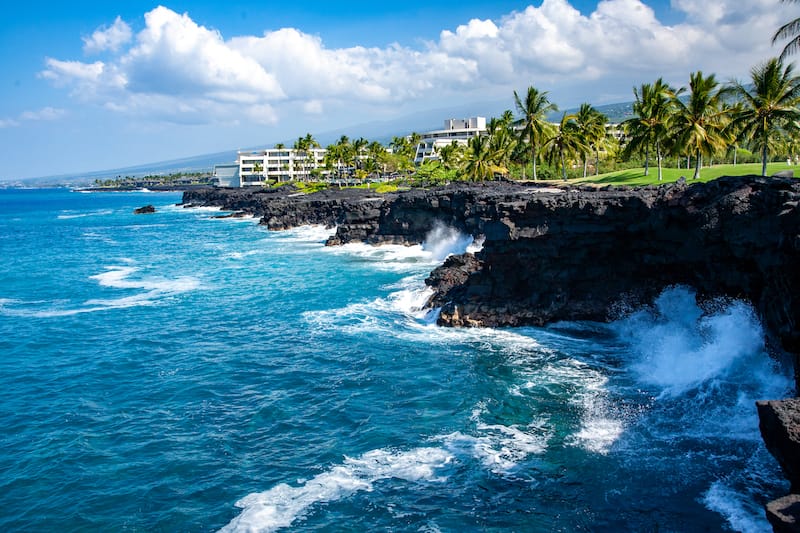Kona’s Natural Beauty and Activities

Kona, on the Big Island of Hawaii, is a paradise where volcanic landscapes meet azure waters, creating a breathtaking tapestry of natural wonders. This region, blessed by the gods, offers a sanctuary for the soul, inviting you to immerse yourself in its diverse ecosystems and experience the thrill of adventure.
The Diverse Landscapes of Kona
Kona’s landscape is a testament to the powerful forces of nature. The island’s volcanic origins are evident in its dramatic topography, with towering mountains, rolling hills, and vast lava fields. The Kohala Mountains, formed by ancient shield volcanoes, rise majestically, their slopes adorned with lush rainforests. In contrast, the Kona Coast is characterized by black sand beaches, formed from volcanic debris, and vibrant coral reefs teeming with marine life. The region’s diverse microclimates support a variety of ecosystems, from the arid, sun-baked slopes of the Kona coffee belt to the lush rainforests of the Hamakua Coast.
Popular Outdoor Activities in Kona
Kona is a haven for outdoor enthusiasts, offering a wide range of activities to suit every taste. The crystal-clear waters of the Pacific Ocean beckon snorkelers and scuba divers to explore the vibrant coral reefs and encounter colorful fish, sea turtles, and even manta rays. For those who prefer to stay on land, hiking trails wind through lush forests and across volcanic landscapes, offering stunning panoramic views. Kealakekua Bay, a historical landmark, is a popular spot for kayaking, stand-up paddleboarding, and sailing.
The Unique Flora and Fauna of Kona
Kona’s diverse ecosystems support a rich tapestry of endemic flora and fauna. The volcanic soils and unique microclimates have fostered the evolution of rare and endangered species, found nowhere else on Earth. The native Hawaiian forests are home to a variety of endemic plants, including the ʻōhiʻa lehua tree, with its vibrant red flowers, and the ʻōhiʻa ʻai, a species prized for its edible fruit. The Hawaiian Monk Seal, an endangered species, finds refuge on Kona’s beaches, while the ʻākepa, a critically endangered honeycreeper, thrives in the forests.
Top Beaches in Kona
Kona boasts some of the most beautiful beaches in Hawaii. Here are five of the best:
| Beach | Features | Accessibility | Best Activities |
|---|---|---|---|
| Keauhou Bay | Calm waters, white sand, sheltered from waves | Easy access, located near resorts and hotels | Snorkeling, swimming, sunbathing |
| Manta Ray Night Dive | Unique opportunity to see manta rays feeding at night | Boat tour required | Scuba diving, snorkeling |
| Hapuna Beach State Recreation Area | Long stretch of white sand, calm waters, lifeguard on duty | Easy access, parking available | Swimming, sunbathing, picnicking |
| Kahaluʻu Beach Park | Protected bay with calm waters, good snorkeling | Easy access, parking available | Snorkeling, swimming, picnicking |
| Mauna Kea Beach Hotel | Exclusive beach with white sand and calm waters | Access for hotel guests and day visitors | Swimming, sunbathing, dining |
Kona’s Culture and History: Kona Hawaii

Kona, nestled on the west coast of the Big Island, holds a profound significance in Hawaiian history and culture. Its volcanic origins, rich natural resources, and strategic location made it a focal point for the ancient Hawaiian Kingdom, shaping its social, political, and spiritual landscape.
Kona’s Role in the Kingdom of Hawaii
Kona played a pivotal role in the development of the Hawaiian Kingdom. Its fertile lands supported a thriving agricultural economy, producing staples like taro, sweet potatoes, and fish. This abundance made Kona a center of trade and power, attracting settlers from across the islands. The region was also a significant center for the production of salt, a valuable commodity used in preserving food and for religious ceremonies.
Cultural Traditions and Practices
The native Hawaiian people of Kona hold deep reverence for their ancestors, their land, and their cultural traditions. Their beliefs are rooted in the interconnectedness of all living things and the importance of maintaining harmony with nature.
Language
The Hawaiian language, a beautiful and complex system of sounds and meanings, is a vital part of Kona’s cultural heritage. It is a language that expresses the unique worldview and values of the Hawaiian people, reflecting their deep connection to their land and their ancestors.
Art Forms
Kona’s cultural heritage is also expressed through its vibrant art forms. Traditional Hawaiian arts like hula, chanting, and carving have been passed down through generations, preserving the stories and values of the Hawaiian people.
Religious Beliefs
The Hawaiian people believe in a pantheon of gods and goddesses, each with specific domains and responsibilities. The most prominent deity is Ku, the god of war, who is also associated with strength and power. Other important deities include Lono, the god of agriculture and fertility, and Kane, the god of creation.
Historical Sites and Museums
Kona is home to several historical sites and museums that offer insights into the region’s rich past.
Pu’uhonua o Honaunau National Historical Park
This park preserves a traditional Hawaiian place of refuge, where those who broke the kapu (sacred laws) could seek sanctuary. The park features ancient temple platforms, petroglyphs, and other archaeological remains, offering a glimpse into the daily life of the ancient Hawaiians.
Kaloko-Honokohau National Historical Park
This park showcases a variety of cultural and natural resources, including fishponds, petroglyphs, and a traditional Hawaiian village. It provides visitors with an opportunity to learn about the sustainable practices of the ancient Hawaiians and their relationship with the environment.
Hulihe’e Palace
This historic palace was the summer residence of Hawaiian royalty and offers a glimpse into the lives of the Hawaiian monarchs. Visitors can explore the palace’s opulent interiors, learn about the history of the Hawaiian monarchy, and see artifacts from the royal family.
Timeline of Significant Events
- Volcanic Origins (Millions of Years Ago): The Big Island, including Kona, was formed by volcanic eruptions over millions of years. The island’s volcanic activity continues to shape its landscape and influence its environment.
- Early Polynesian Settlement (c. 1000 AD): The first Polynesian settlers arrived in Hawaii, establishing a thriving culture and society based on agriculture, fishing, and trade.
- Establishment of the Kingdom of Hawaii (1795): Kamehameha the Great, a powerful warrior chief, unified the Hawaiian islands, establishing the Kingdom of Hawaii. Kona played a key role in Kamehameha’s rise to power, providing him with resources and a strategic base.
- Captain Cook’s Arrival (1778): British explorer Captain James Cook arrived in Hawaii, marking the beginning of contact with Western civilization. Cook’s arrival had a profound impact on Hawaiian society, introducing new technologies, ideas, and diseases.
- The Great Mahele (1848): The Hawaiian monarchy implemented a land redistribution program, known as the Great Mahele, which divided land among the Hawaiian people, the monarchy, and foreigners.
- The Overthrow of the Monarchy (1893): A group of wealthy businessmen, supported by the United States, overthrew the Hawaiian monarchy, leading to the annexation of Hawaii by the United States in 1898.
- Modern Times: Kona has become a popular tourist destination, attracting visitors from around the world. The region’s rich cultural heritage, stunning natural beauty, and thriving economy continue to draw people to its shores.
Kona’s Food and Drink

Kona’s culinary scene is a vibrant fusion of local flavors and international influences, reflecting the island’s rich history and diverse population. The island’s volcanic soil and tropical climate create ideal conditions for growing an abundance of fresh, seasonal produce, which forms the foundation of many dishes.
Local Cuisine and Ingredients
Kona’s culinary scene is renowned for its emphasis on fresh, local ingredients. The island’s volcanic soil and tropical climate create ideal conditions for growing a wide variety of fruits, vegetables, and seafood.
- Fresh Seafood: Kona’s waters are teeming with a variety of fish, including mahi-mahi, ono, and aku. These fish are often grilled, baked, or served in poke, a popular Hawaiian dish of raw fish marinated in soy sauce, sesame oil, and other seasonings.
- Tropical Fruits: Kona is home to a variety of tropical fruits, including mango, papaya, pineapple, and guava. These fruits are often used in smoothies, salads, and desserts.
- Local Produce: The island’s fertile soil produces a variety of vegetables, including tomatoes, cucumbers, and onions. These vegetables are often used in traditional Hawaiian dishes like kalua pig, a slow-cooked pork dish wrapped in ti leaves.
Kona Coffee Culture
Kona coffee is world-renowned for its unique flavor and aroma. The island’s volcanic soil, high altitude, and ample rainfall create ideal conditions for growing coffee beans. The beans are hand-picked and processed using traditional methods, resulting in a smooth, complex flavor profile.
- Growing Conditions: Kona coffee is grown on the slopes of the Hualalai volcano, where the rich volcanic soil, high altitude, and ample rainfall create ideal growing conditions. The beans are hand-picked and processed using traditional methods, resulting in a smooth, complex flavor profile.
- Production Process: Kona coffee beans are carefully hand-picked and processed using traditional methods. The beans are first pulped, then fermented and dried in the sun. The dried beans are then roasted and ground to create the final product.
- Tasting Experience: Kona coffee is known for its smooth, complex flavor profile with notes of chocolate, caramel, and nuts. The coffee is often served black or with a splash of milk.
Recommended Restaurants in Kona
Kona offers a wide variety of restaurants, from casual cafes to fine dining establishments. Here are a few recommendations, categorized by cuisine and price range:
- Umeke’s Fish Market Bar & Grill: This casual restaurant serves fresh seafood, local produce, and Hawaiian-inspired dishes. (Price Range: $$)
- Huggo’s on the Rocks: This upscale restaurant offers stunning ocean views and a menu featuring fresh seafood, steaks, and pasta dishes. (Price Range: $$$)
- The Kona Brewing Company: This popular brewery serves a variety of craft beers and pub fare, including burgers, sandwiches, and salads. (Price Range: $$)
- The Coffee Beanery: This cozy cafe offers a variety of coffee drinks, pastries, and sandwiches. (Price Range: $)
- The Old Kona Airport State Historical Park: This park is home to a variety of restaurants, including a cafe, a restaurant, and a bar. (Price Range: $$)
Top 5 Kona Coffee Farms, Kona hawaii
| Coffee Farm | History | Unique Offerings | Tasting Experience |
|---|---|---|---|
| Kona Coffee Belt | Established in the early 1900s, the Kona Coffee Belt is home to a variety of coffee farms, each with its own unique history and tradition. | The Kona Coffee Belt offers a wide variety of coffee beans, from the traditional Kona Extra Fancy to the more rare Kona Peaberry. | Visitors can take a tour of the farm and learn about the coffee-growing process, from bean to cup. |
| Holualoa Coffee Company | Founded in 1990, Holualoa Coffee Company is known for its commitment to sustainable farming practices. | The company offers a variety of coffee beans, including its signature “Holualoa Blend” and “Estate Reserve.” | Visitors can enjoy a cup of coffee at the company’s tasting room, where they can learn about the different types of coffee beans and brewing methods. |
| Kona Mountain Coffee | Founded in 1982, Kona Mountain Coffee is a family-owned and operated coffee farm that has been growing coffee for over three generations. | The farm offers a variety of coffee beans, including its signature “Kona Mountain Blend” and “Estate Reserve.” | Visitors can take a tour of the farm and learn about the coffee-growing process, from bean to cup. |
| Greenwell Farms | Founded in 1974, Greenwell Farms is a family-owned and operated coffee farm that is known for its commitment to sustainable farming practices. | The farm offers a variety of coffee beans, including its signature “Greenwell Blend” and “Estate Reserve.” | Visitors can enjoy a cup of coffee at the farm’s tasting room, where they can learn about the different types of coffee beans and brewing methods. |
| Hula Daddy Coffee | Founded in 2008, Hula Daddy Coffee is a small-batch coffee roaster that is known for its unique blends and single-origin coffees. | The company offers a variety of coffee beans, including its signature “Hula Daddy Blend” and “Estate Reserve.” | Visitors can enjoy a cup of coffee at the company’s tasting room, where they can learn about the different types of coffee beans and brewing methods. |
Kona hawaii – Kona, Hawaii, is a beautiful destination with stunning beaches, lush rainforests, and active volcanoes. If you’re looking for a way to get there, consider checking out the latest Alaska Airlines BOGO deals. You might just find a great flight that’ll make your Kona vacation even more affordable.
Kona, Hawaii, is a beautiful destination known for its stunning beaches and volcanic landscapes. Whether you’re interested in surfing, snorkeling, or simply relaxing on the sand, Kona has something to offer everyone. To find the best flight deals to this tropical paradise, consider using google flighta , a convenient tool that compares prices from multiple airlines and helps you snag the best deals.
Once you arrive in Kona, be sure to explore the charming town of Kailua-Kona, with its historic sites and vibrant nightlife.
